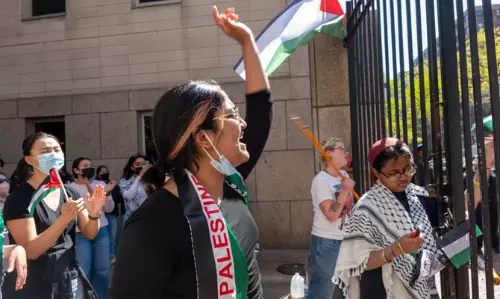
The communal call from Dharmasabha
text_fieldsNearly five hundred sanyasis and tens of thousands of RSS/VHP volunteers assembled in Ayodhya, Uttar Pradesh. There were reports that the event, titled Dharmasabha was held to announce the date and schedule of construction of a temple at the site in Ayodhya where Babari Masjid stood and was demolished in 1992.
Although it was declared that the event rallying a lakh of people each from RSS and VHP would be the largest ever since the demolition of the masjid, later reports show that the participants numbered merely half that. The sabha also issued certain ultimata and warning to the Central Government regarding the construction of Ram temple. The main demand raised by the RSS leaders and the chief saints was an ordinance should be passed for building the temple. Shiv Sena leader Uddhav Thackeray who came over from Mumbai at the same time, and held another programme with an arati in River Sarayu with 7,000 followers, issued certain other warnings too to Modi government.
It was at a similar dharmasansad 26 years ago, convened by Sangh Parivar gathering 500 saints, that they declared the construction of a Ram temple in the place where the Babari masjid stood. With the history of that gatherng with 70,000 karsevaks leading to the demolition of the mosque and communal riots, tension and anxiety were high about the rally on Sunday. Minorities fled the area in large numbers. But no major declarations regarding the temple construction were made on that day. At the same time, the Dharmasabha served to reveal the Sangh Parivar's preparations to incite communal hatred to the utmost, driven by the conviction that even after being in power for a full term, there is nothing in its balance sheet to show for the upcoming election. The statements that emanated from the sabha included these: courts and the constitution are not above Ram, those who demolished the mosque know how to build a temple, and they will not hesitate to take law into their hands for that, the disputed 2.77 acre land should entirely be handed over to Hindus, and with the ascent of a Ram temple and a Ram statue, India should be declared a Hindu state. The Sangh Parivar and the sanyas also issued threats such as that they will not stop with Ayodhya, but will bring down 40,000 other mosques in the country in addition to those in Kashi and Mathura and build temples there, they will not allow building of a mosque in Ayodhya, and if any attempt is made for that they will construct a temple even in Mecca.
In fact the constructin of a Ram temple in Ayodhya by demolishing the Babari masjid that stood there, is just a trump card to expedite communal polarization in the country and capture power through that. As for the Sangh Parivar, bereft of any ideological foundation or sense of direction that can strengthen a party or run a government , all it can do to present in and out of the government is politics and culture of hatred towards the other. To them, more imortant than god, incarnation, faith and custom are alienation and theory and practice of elimination. It is the same hymns dictated by its architect Savarkar during the birth of the Sangh, that one could hear in Ayodhya and also in Sabarimala. If any one wants to check the element of sincerity they had in the issues they highlight beyond these chantings, he can easily examine its track record in Ayodhya. Although RSS Sarsangh Chalak made the usual Dasara lecture on every vijayadashami day in the four years after Narendra Modi took office, he did not speak about Ram temple. Finally, it was in this year's lecture when Modi is about to complete his term and going to face the next election, that he raised the issue of Ram temple. The reason is simple: despite being in office for four years, there is nothing much to show as achievements of the government. And there are many failings to cite that brought popular ire. Therefore, in order to shore up itself in the next election, there is no alternative than to sink India in the politics of polarization. This is a crisis faced by the Sangh Parivar outfits separately and collectively. That is why, RSS, VHP and Shiv Sena all came out at the same time, vying with one another in the matter of temple construction.
As for BJP, which rode into power by seeking a vote for change, not only was it able to advance by even an inch from the position of predecessor Congress, all it could achieve was an exercise of giving the Congress-led government's plans and programmes new saffron names and painting that colour on them. And to cover up this helplessness and inefficiency, the Sangh Parivar is again seeking the path of communal contamination, an art they are adept at. It is as a part of it that they made the dharmasabha a venue to declare a war against minorities, although lacking in clarity about the Ram temple. For the Sangh Parivar it does not matter to them as to which culture the sanyas chiefs represent when they conduct a dharmasabha to make Ayodhya and Ram a tool for communal extermination. The BJP MLA and leader of Ayodhya agitation Surendra Singh who has vowed not to give in to Shiv Sena in its devotion to Ram, asks how Shiv Sena which drives away north Indians and who does not care to serve humanity, can serve Bhagwan Ram. If that is so, which Bhagwan would the BJP be serving when it terrorises the whole nation by raising construction of the temple in the name of Ram?























